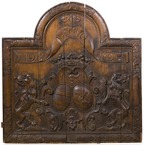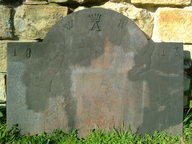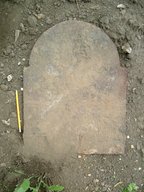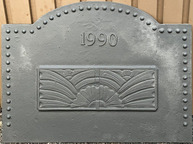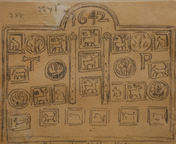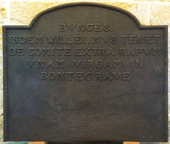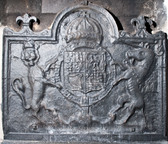-
937
Description: Arched rectangular shape; gadrooned edging (top and sides); initials, in separate stamps, at top of arch; date probably in separate stamps, below, split by spindle; spindle used as a stamp repeated three times, one between date and initial stamps, the other two below to left and right.
Notes: Makes use of the same backing board as other firebacks in this series, and is possibly a variant of another fireback of the same date and with the same three spindles but with other initials (no. 299); it may originate in the Cuckfield area of Sussex, where most examples have been noted; illustration from Harper (1906). Previously at Riddens (now West Riddens) Farm, Ansty, near Cuckfield, Sussex.
Inscription: S WC / 16 22
- Decoration tags:
- arched rectangular (shape)
- gadrooned (edging)
- simple stamps
- individual letters
- individual numbers
- text
- objects
Manufactured: in 1622 possibly at Cuckfield Furnace in the Weald area of England.
Current location: not known.
Citation: Harper, C. G., 1906, The Brighton Road (London, Chapman & Hall), p. 391.
- Attached to series:
- Spindle series
- Date & initials firebacks
- Spindle/distaff firebacks
-
1139
Description: Arched rectangular shape; fillet edging to a rounded frame with sections of acanthus leaves at the corners and at the top of the arch, and blank campartments in between; astragal and fillet inside edging; arched rectangular inscription scroll suspended with faux ribbon from the top of the arch; below, a coronet over a large baroque cartouche containg two oval shields: Massenbach - azure two bars or, d'Helmstadt - argent a crow sable; on either side, lion rampant reguardant supporters; four vertical planklines.
Notes: A finely executed carving. Nicolas de Massenbach (1659-1722) and Francoise d'Helmstadt (d.1729) were married at Ourches-sur-Meuse, in Lorraine, in 1695.
Inscription: NDM 1710 FDH
Arms: Nicolas de Massenbach and Francoise d'Helmstadt
- Decoration tags:
- arched rectangular (shape)
- fillet (edging)
- whole carved pattern
- planklines
- heraldic
- armorial
- text
Manufactured: in 1710 in France.
Current location:, not known.
Citation: Palasi, P., 2014, Plaques de Cheminées Héraldiques (Paris, Éditions Gourcuff-Gradenigo).
- Attached to series:
- Patterns
-
14
Description: Arched rectangular shape; plain plate. Crowned capital ‘A’ between ‘W’ and ‘R’; divided date at top extremities of plate; single six-pointed star below ‘A’.
Notes: Earl’s coronet denotes the Earl of Ashburnham, furnace owner; ‘WR’ denotes William Rummins, furnace founder; 1813 - the furnace was blown out for the last time in late February 1813. Similar to, but narrower than the fireback at Church Farm, Penhurst (in private hands), and uses the same cipher and numbers. One of a small series of firebacks cast in the early-19th century for farms on the Ashburnham estate; this example was formerly at Great Sprays Farm, Penhurst.
Inscription: W A R / 18 * 13
- Decoration tags:
- arched rectangular (shape)
- none (edging)
- carved stamps
- individual letters
- individual numbers
- heraldic
- text
- objects
Manufactured: in 1813 at Ashburnham Furnace in the Weald area of England.
Current location: in private hands, Ashburnham, East Sussex, England.
- Attached to series:
- Ashburnham late series
- Date & initials firebacks
-
15
Description: Arched rectangular shape; no edging.
Notes: The plain form suggests a common source with firebacks cast at Ashburnham in 1813. One of a small series of firebacks cast in the early-19th century for farms on the Ashburnham estate.
- Decoration tags:
- arched rectangular (shape)
- none (edging)
Manufactured: in the early 19th century probably at Ashburnham Furnace in the Weald area of England.
Current location: in private hands, Ashburnham, East Sussex, England.
- Attached to series:
- Ashburnham late series
- Base boards
-
849
Description: Rectangular with superimposed arch; embattled, cavetto moulded edging, with the top edge of the rectangle interrupted; shield, garter, crown, supporters and motto of the English Royal house of Stuart; rose and thistle plants above lion and unicorn supporters respectively; initials split by crown; date below garter.
Notes: A version dated 1619 is proportioned slightly differently and has smaller rose and thistle plant stamps.
Copies of this fireback are known.
Inscription: I R / 16 21
Arms: English Stuart royal - James I
- Decoration tags:
- arched rectangular (shape)
- embattled cavetto (edging)
- whole carved pattern
- armorial
- royal
- text
Manufactured: in 1621 in England.
Current location: in private hands, Ashurst, West Sussex, England.
-
1270
Description: Arched rectangular shape; plain edge with 49 large beads parallel with top and sides; upper centre, date in bold Arabic numerals; below date, raised rectangular panel with chamfered sides and corners and fillet edging, and a symmetrical sunburst and rainbow design in low relief.
Notes: Modern, quasi-Art Deco design
Inscription: 1990
- Decoration tags:
- arched rectangular (shape)
- none (edging)
- whole carved pattern
- individual numbers
- text
- objects
Manufactured: in 1990 in England.
Current location: in private hands Bedford, Bedfordshire, England.
- Attached to series:
- Miscellaneous pattern firebacks
- 1990s Art Deco series
-
966
Description: Arched rectangular shape; ovolo moulded edging; date in arch; below arch two parallel, vertical straps, each with a buckle at the top; initials left and right of centre; roughly symmetrical arrangement of four stamps repeated: rectangular stamp with deer three times down centre, one outside each buckle and one beyond each strap end; circular food mould stamp outside centre of each strap, beyond stag stamp outside buckle and at edge beyond strap end; 'rabbit' stamp at edge beyond food mould stamp outside each buckle and outside each strap end; rectangular stamp with 'dog' outside each initial and six times below strap ends.
Notes: The buckles suggest a connection with the Pelham family; the initials may relate to Sir Thomas Pelham, Bt. (1597-1654) who owned and operated ironworks at Waldron in Sussex. From the drawing the seven 'deer' stamps appear to be the same as those seen on two other examples of this fireback. The food mould stamp (centre left and right) appears to be one seen repeated on at least one other fireback. Drawing of a fireback at Huggetts Farm, Waldron, Sussex, by Edward Hughes, of Heathfield, Sussex; J. Starkie Gardner collection, Victoria & Albert Museum, Archive of Art and Design (AAD/2014/8).
Inscription: 1642 / T P
- Decoration tags:
- arched rectangular (shape)
- ovolo (edging)
- carved stamps
- whole carved pattern
- individual letters
- text
- animals
- objects
Manufactured: in the mid 17th century probably at Waldron Furnace in the Weald area of England.
Current location:, not known.
Citation: Gardner, J. S., 1898, 'Iron Casting in the Weald', Archaeologia, 56, 1, pp. 133-164.
- Attached to series:
- 1642 Pelham series
- Pelham family firebacks
- Food mould stamp firebacks
-
1205
Description: Arched rectangular shape; cavetto moulded edging; top centre within arch, initials above date.
Notes: Plain elegant fireback from a late series, probably cast in the south east of England. The crack emanating from the top right corner of the fireback seems to be a weakness on all the recorded examples, and may have caused by thinness of the base board at that point.
Inscription: R.R / 1857
- Decoration tags:
- arched rectangular (shape)
- cavetto (edging)
- carved stamps
- individual letters
- individual numbers
- text
Manufactured: in 1857 in England.
Current location: in private hands, Horsted Keynes, West Sussex, England.
- Attached to series:
- 1850s series
- Date & initials firebacks
-
1206
Description: Arched rectangular shape; twisted rope edging (top and sides); top, centred, text in five lines uppercase with the letter 'U' represented as 'V'.
Notes: Apart from the word 'Bunces' the text is an expanded transcription of the entry in the Domesday Book for Birch Grove, south of East Grinstead. Allegedly it was the author, Rudyard Kipling, who suggested to the then owner of that property that the text be used to decorate a fireback.
Inscription: BVNCES. / ISDEM WILLELMVS TENET / DE COMITE EXTRA RAPVM / VNAM VIRGAM IN / BONTEGRAVE
- Decoration tags:
- arched rectangular (shape)
- rope (edging)
- whole carved pattern
- text
Manufactured: in the early 20th century in England.
Current location: in private hands, Horsted Keynes, West Sussex, England.
- Attached to series:
- Commemorative firebacks
-
1208
Description: Arched rectangular shape with a fleur-de-lys springing from each shoulder; cyma recta-moulded edging; quartered shield of the Stuart royal arms of England with surrounding Garter, surmounted by a crown and supported by a crowned lion and unicorn; indistinct motto cartouche along the bottom.
Notes: A poorly-modelled and much-worn fireback. The fleur extensions to the top of the edging are an unusual feature
Arms: English Stuart royal
- Decoration tags:
- arched rectangular (shape)
- cyma recta (edging)
- whole carved pattern
- heraldic
- armorial
- royal
Manufactured: in the 17th century in England.
Current location: Blackwell House, Bowness-on-Windermere, Cumbria, England.
- Attached to series:
- Stuart royal armorial firebacks
.jpg)
